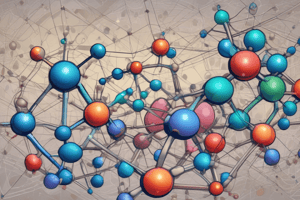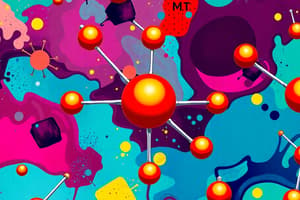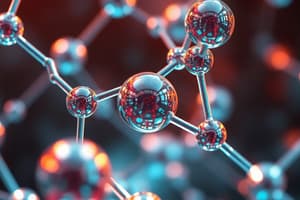Podcast
Questions and Answers
What happens to the oxidation state and coordination number of the metal in this process?
What happens to the oxidation state and coordination number of the metal in this process?
- They both increase
- They remain unchanged (correct)
- They both decrease
- They are not affected by the process
How many mechanisms are involved in this process?
How many mechanisms are involved in this process?
- One
- Two (correct)
- Three
- Four
What is the rate-determining step in the dissociative mechanism?
What is the rate-determining step in the dissociative mechanism?
- The fast step
- The last step
- The slow step (correct)
- The first step
What type of liaisons are involved in the concerted mechanism with 3 centers?
What type of liaisons are involved in the concerted mechanism with 3 centers?
What is similar to the dissociative mechanism in organic chemistry?
What is similar to the dissociative mechanism in organic chemistry?
What is the geometry of the product formed in the concerted mechanism?
What is the geometry of the product formed in the concerted mechanism?
What is the formula of the metal complex at the beginning of the process?
What is the formula of the metal complex at the beginning of the process?
What happens to the number of electrons during the reaction?
What happens to the number of electrons during the reaction?
What is the product of the process?
What is the product of the process?
What type of addition is necessary for the resulting intermediate to stabilize?
What type of addition is necessary for the resulting intermediate to stabilize?
How many types of mechanisms regulate the synthesis of Grignard reagents?
How many types of mechanisms regulate the synthesis of Grignard reagents?
What happens to the coordination number of the metal in the dissociative mechanism?
What happens to the coordination number of the metal in the dissociative mechanism?
Which of the following can be coupled together?
Which of the following can be coupled together?
Which of the following mechanisms is analogous to the mechanism in organic chemistry?
Which of the following mechanisms is analogous to the mechanism in organic chemistry?
What is a characteristic of metals that makes oxydative coupling easier?
What is a characteristic of metals that makes oxydative coupling easier?
What is the role of L in the dissociative mechanism?
What is the role of L in the dissociative mechanism?
What is the general formula of the reactants in the synthesis of Grignard reagents?
What is the general formula of the reactants in the synthesis of Grignard reagents?
What is the product of the synthesis of Grignard reagents?
What is the product of the synthesis of Grignard reagents?
What is the general trend in the reactivity of alcynes versus alkenes?
What is the general trend in the reactivity of alcynes versus alkenes?
What is the role of the metal complex in the reaction?
What is the role of the metal complex in the reaction?
What is the result of the elimination of a ligand L in a complex?
What is the result of the elimination of a ligand L in a complex?
What is the general purpose of the II-3 elimination reaction?
What is the general purpose of the II-3 elimination reaction?
What type of reaction is represented by the equation HCo(CO)4 → HCo(CO)3 + CO?
What type of reaction is represented by the equation HCo(CO)4 → HCo(CO)3 + CO?
What is the maximum number of electrons in the complex LnM in an oxidative addition reaction?
What is the maximum number of electrons in the complex LnM in an oxidative addition reaction?
What is the oxidation state of the metal in the complex Ni(CO)3?
What is the oxidation state of the metal in the complex Ni(CO)3?
What type of ligands are involved in an oxidative addition reaction?
What type of ligands are involved in an oxidative addition reaction?
What is the result of the reaction Pt(PPh3)3 + PPh3 → Pt(PPh3)4?
What is the result of the reaction Pt(PPh3)3 + PPh3 → Pt(PPh3)4?
What is the general equation for the II-3 elimination reaction?
What is the general equation for the II-3 elimination reaction?
What is the advantage of using rhodium complexes over palladium complexes?
What is the advantage of using rhodium complexes over palladium complexes?
What is the outcome of the elimination reaction (4) in the scheme?
What is the outcome of the elimination reaction (4) in the scheme?
What is the role of the metal (Rh) in the scheme?
What is the role of the metal (Rh) in the scheme?
What is the reactant that undergoes hydrogenation in the scheme?
What is the reactant that undergoes hydrogenation in the scheme?
What is the catalyst used in the hydrogenation reaction?
What is the catalyst used in the hydrogenation reaction?
What is the net result of the reaction sequence?
What is the net result of the reaction sequence?
What is the significance of the scheme?
What is the significance of the scheme?
Who is the author associated with the hydrogenation mechanism?
Who is the author associated with the hydrogenation mechanism?
Flashcards are hidden until you start studying
Study Notes
Organometallic Reactions
- The degrees of oxidation and coordination of the metal, as well as the number of valence electrons, remain unchanged during the process.
- The process occurs according to two limiting mechanisms: dissociative and associative.
Dissociative Mechanism
- Resembles the SN1 mechanism in organic chemistry.
- Example: Ni(CO)4 → Ni(CO)3 + CO
- Rate-determining step: slow, followed by a rapid step.
Elimination Non-Reductive
- Generally, the non-oxidative addition (Lewis base) is equilibrated in solution with the reverse reaction, which involves the dissociation of the M-L bond, i.e., the elimination of a ligand L.
- Example: HCo(CO)4 → HCo(CO)3 + CO
- The reaction releases a coordination site, and the number of electrons in the complex decreases by 2 units.
Oxidative Addition
- Corresponds to the scheme: LnM + A → B → LnM
- Involves the addition of an electron-deficient ligand A, resulting in the formation of a 3-coordinate intermediate.
- Four types of mechanisms govern this type of reaction:
- Concerted 3-center mechanism
- SN2-like substitution mechanism
- Radical mechanism
- Ionic mechanism
Concerted 3-Center Mechanism
- Involves apolar or weakly polar bonds (H-H, O-O, H-Si, H-C, etc.)
- The product forms with a cis geometry, and the number of electrons decreases by 2 units, resulting in an unstable, non-isolable intermediate.
- A subsequent non-oxidative addition is necessary to stabilize the product.
Catalytic Applications
- Alkynes couple more easily than alkenes, and the coupling is facilitated by the basicity (electron richness) of the metal.
- It is possible to couple two carbene molecules or a carbene and an olefin.
- The alkane is obtained through reductive elimination (4) after insertion (3).
- The Halpern mechanism (1977) illustrates the catalytic cycle of olefin hydrogenation.
Catalysis with Palladium
- Rhodium complexes offer better regioselectivity than palladium complexes.
Studying That Suits You
Use AI to generate personalized quizzes and flashcards to suit your learning preferences.




